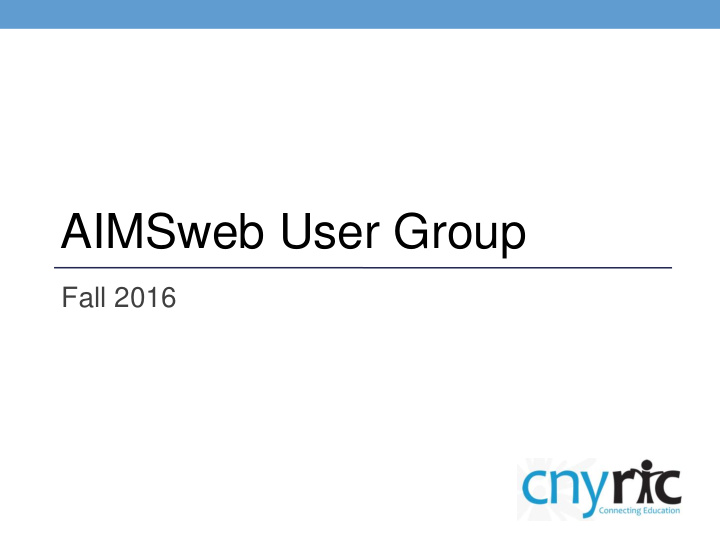



AIMSweb User Group Fall 2016
Today’s Focus • From Big Picture to the Details • Key Reports and Data for Decision-Making • Connecting AIMS Measures and Interventions • Progress Monitoring on and off grade level • Future of AIMSweb
RTI and AIMS
Types of Data • Performance • Compared to National Norms • Compared to a Target • Growth • Compared to other like students in the norms • Between different screening periods • Progress Monitoring
Ways to View the Data • Big Picture Level (district, grade level, classroom) • What is the overall performance of this group? • How is core instruction impacting performance and growth? • Student Level • Where does this student succeed/struggle? • What is the impact of instruction/interventions?
The Big Picture Reports • Above/Below Target • Score Distribution • Tier Transition • Rate of Improvement
Above/Below Target
Tier Transition- Grade and Classroom
ROIs- Grade and Classroom Growth of the Local Group National Norms form Growth
Impact of Core Instruction • What is the breakdown of our grade/class performance against national norms? • What is the overall growth and movement of our grade level/classroom on the measure(s)? • What trends exist over multiple years?
The Student Detail Reports • Scores and Percentiles (rainbow report) • Instructional Recommendations • Scores and Percentiles (target) • Common Core Reports • Individual Growth Reports
Instructional Recomendation
Scores and Percentiles
Target Comparisons
Common Core Report
Growth Reports
Multiple Years
Impact of Core and Interventions • Which students may be in most need of interventions? • What can we tell about student needs from the measures? • Do rosters tied to interventions or individual growth reports show progress? • What does past data show?
Steps to Effective Monitoring 1. Identify students who may be at-risk 2. Identify the skill deficit and specific need of student 3. Define an appropriate intervention to meet those needs 4. Select an appropriate progress monitoring measure 5. Set growth goals 6. Consistently use data to assess impact of intervention
Purpose of Progress Monitoring
Off Grade Level Find Grade/Goal GENERALLY Stay on Level Material if . . . Grade Level if . . . In Grades 3 or above and perform If perform above the 10th below the 10th percentile percentile at grade level – “red” zone, on rainbow report – “yellow” or “green” zone, on – blue dot, below the orange rainbow report – blue dot, on orange whisker or whisker! above (in green box or on blue whisker) In Grade 2 and cannot read more than 10 words on a grade level If below the 10th at grade level passage. but in the average range on the grade level below. In Kinder or 1st grade
The Basic Idea Above the 10 th This is the goal level percentile? Drop back by Below the 10 th successive grade percentile? levels until above the 10th percentile
Survey Level Assessment Grade 5 Student – 25 correct on RCBM benchmark • Administer grade 4 - RCBM • 32 corrects, 8 errors on fall grade 4 RCBM • Administer grade 3 RCBM • 43 corrects, 6 errors • Administer grade 2 RCBM • 52 corrects, 6 errors
Product Overview 2016-17
What is the same? • CBMs: Still makes use of many quick, one-to-one standardized and normed assessments • Tests of Early Literacy/Numeracy • Oral Reading Fluency (ORF) • Computer-assisted scoring • Access to national/local norms, growth percentiles, and criterion-based data for groups and individuals • Progress monitoring and off-grade level progress monitoring
What are the main differences? • Updated website – key information more easily accessible • Much more flexibility and ease of use in computer-assisted scoring and progress monitoring • Redesigned and newly developed measures aligned to Common Core • More data, and more useful information by student and skill • Online assessments
Early Literacy Measures
Early Literacy Schedule
Early Numeracy Measures
Early Numeracy Schedule
Reading Measures and Schedule
Math Measures and Schedule
Recommend
More recommend